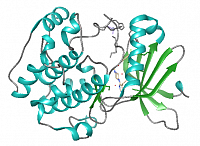
The mTOR signalling pathway plays a highly conserved role in aging [Selman, Colin, et al. "Evidence that hematopoietic stem cell function is preserved during aging in long-lived S6K1 mutant mice." Oncotarget (2016).]. Recent studies demonstrate that the mammalian target of rapamycin (mTOR) lies at the crossroads of a signaling network that is involved in specific pathological responses, including obesity, diabetes and cancer [Dann, Stephen G., Anand Selvaraj, and George Thomas. "mTOR Complex1–S6K1 signaling: at the crossroads of obesity, diabetes and cancer." Trends in molecular medicine 13.6 (2007): 252-259.]. S6K1 has emerged as a crucial effector of mTOR signaling. In their publication Dr. Selman and co-authors have shown that mice lacking ribosomal S6K1 have extended lifespan and healthspan relative to wild type controls. Exactly how reduced mTOR signalling induces such effects is unclear, although preservation of stem cell function may be important. It is assumed that S6K1 blockade is a valid pharmacological approach to improve glucose disposal in obese diabetic individuals [Shum, Michael, et al. "Pharmacological inhibition of S6K1 increases glucose metabolism and Akt signalling in vitro and in diet-induced obese mice." Diabetologia (2016): 1-12.]. Moreover, S6K1 inhibitors may have therapeutic implications for some neuropsychiatric conditions involving aberrant mTORC1-S6K1 signaling [Bhattacharya, Aditi, et al. "Targeting Translation Control with p70 S6 Kinase 1 Inhibitors to Reverse Phenotypes in Fragile X Syndrome Mice." Neuropsychopharmacology (2015).].
Our company suggests development of the compounds, which will inhibit S6K1 kinase in human cells. We suggest multi-step strategy, involving virtual screening, high-throughput screening, in silico drug design, ADME/Tox and pharmacokinetics optimization and other preclinical development of clinical trials candidate compounds. If you choose our investment project, you will be able to get income of 1 - 2 mln. usd. (estimated cost of clinical trials candidate) in around 2-3 years of preclinical drug development.